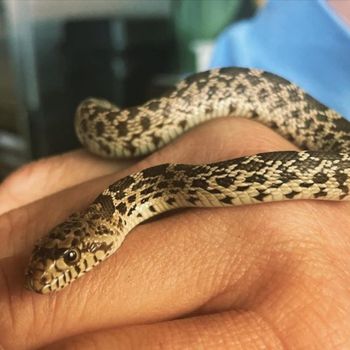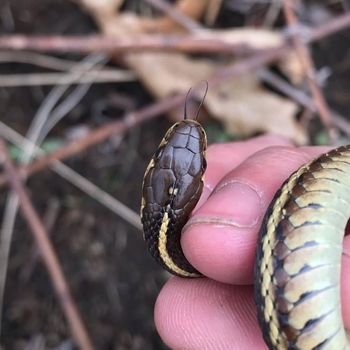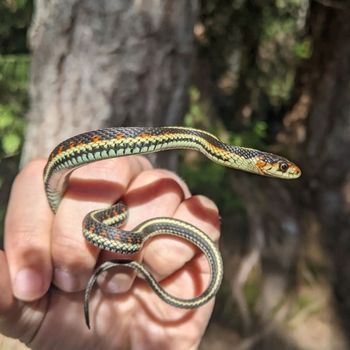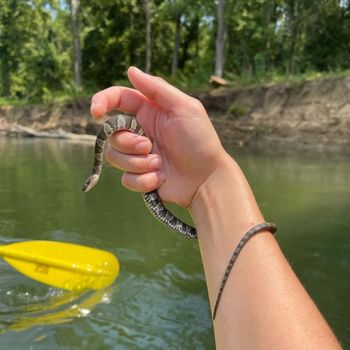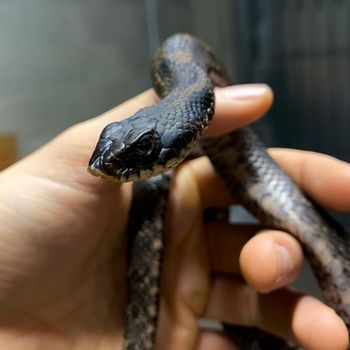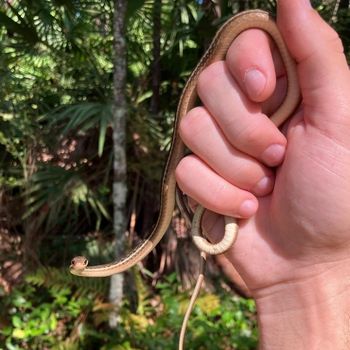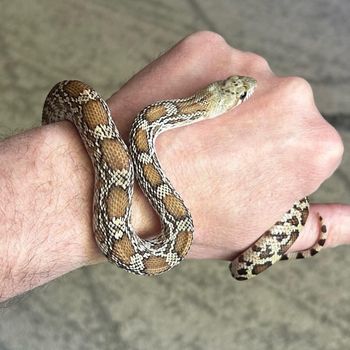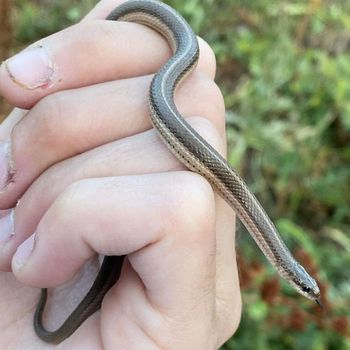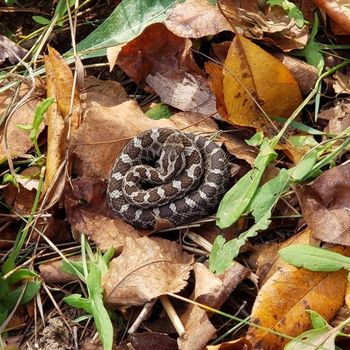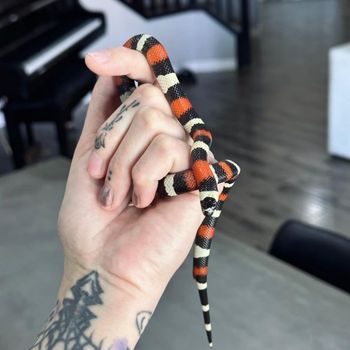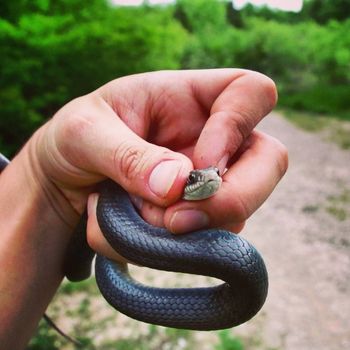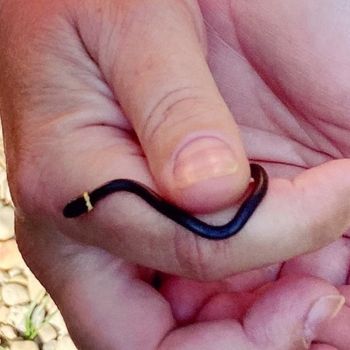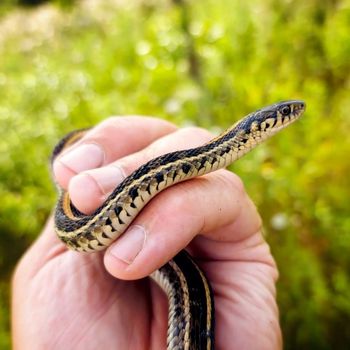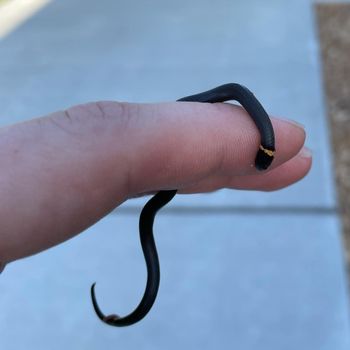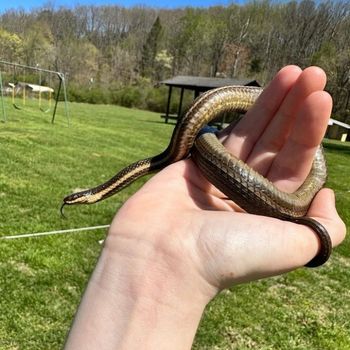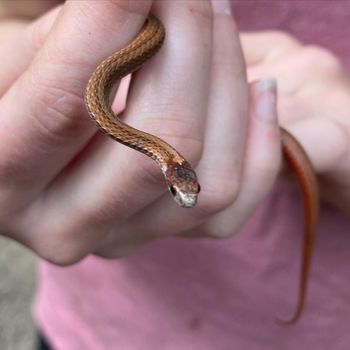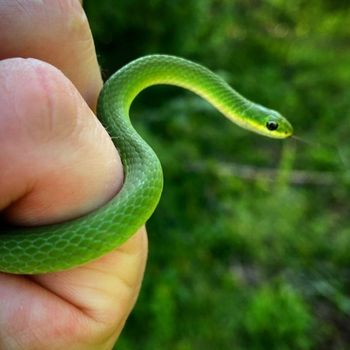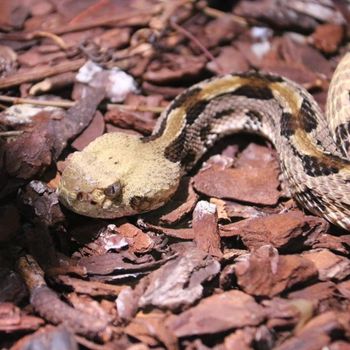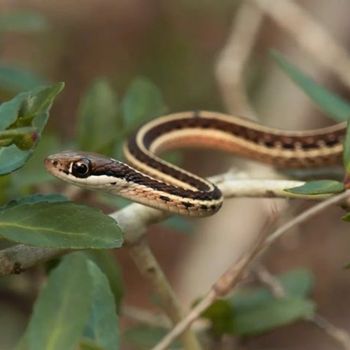Snakes in Wisconsin: Adorable Badger Slitherers
Ever wondered how many slithery, legless reptiles call Wisconsin their home? Well, you’re in luck! It turns out that there is a surprisingly diverse array of serpents residing in our beautiful state.
While you’re exploring the great outdoors in Wisconsin, you might just encounter one or more of the 23 species of snakes that call this place home. That’s right — 23 different species!
From the venomous to the completely harmless, we’ve got all sorts of fascinating snakes dwelling among us. So let’s dive into the world of these scaly creatures and learn more about our slithering neighbors.
| # | Name | Details | Image |
| 1 | Black Rat Snake (Pantherophis obsoletus) |
| 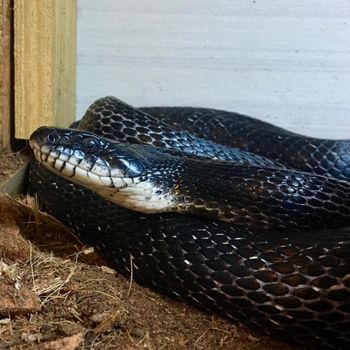 |
| 2 | Bullsnake (Pituophis catenifer sayi) |
| 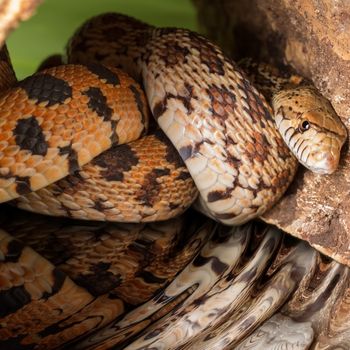 |
| 3 | Butler’s Gartersnake (Thamnophis butleri) |
| 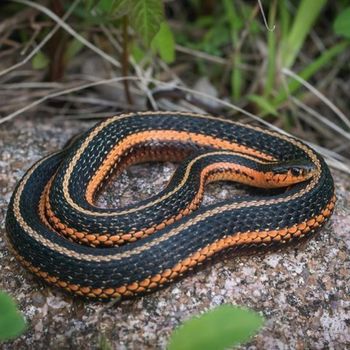 |
| 4 | Common Garter Snake (Thamnophis sirtalis) |
| 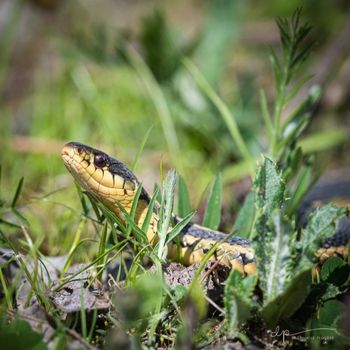 |
| 5 | Common Water Snake (Nerodia sipedon) |
| 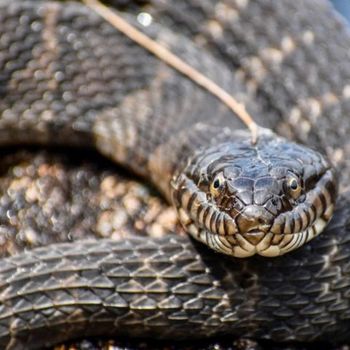 |
| 6 | Dekay’s Brownsnake (Storeria dekayi) |
| 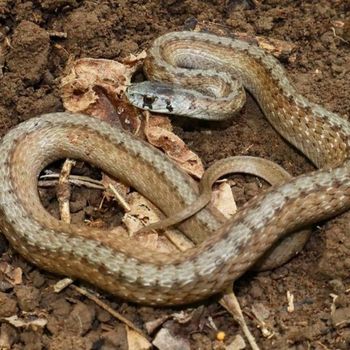 |
| 7 | Eastern Fox Snake (Pantherophis gloydi) |
| 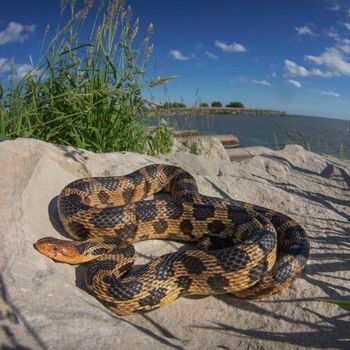 |
| 8 | Eastern Hog-nosed Snake (Heterodon platirhinos) |
| 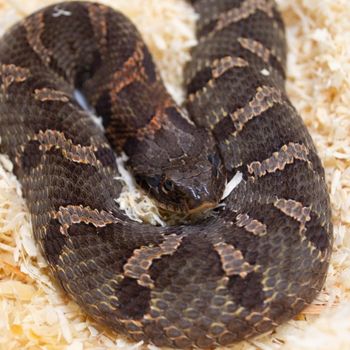 |
| 9 | Eastern Ribbon Snake (Thamnophis sauritus sauritus) |
|  |
| 10 | Gophersnake (Pituophis catenifer) |
| 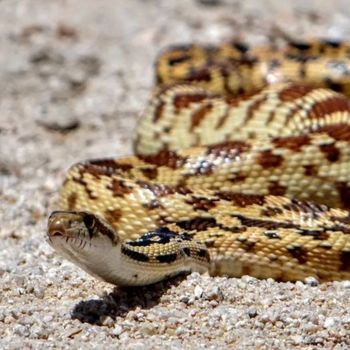 |
| 11 | Lined Snake (Tropidoclonion lineatum) |
| 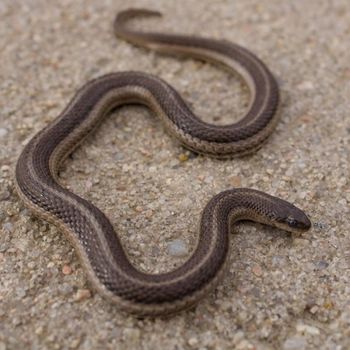 |
| 12 | Massasauga Rattlesnake (Sistrurus catenatus) |
| 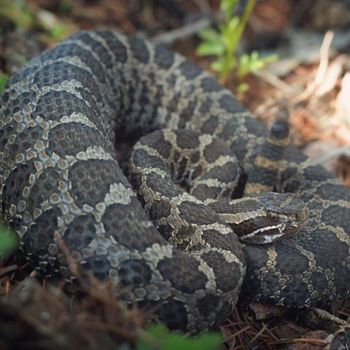 |
| 13 | Milksnake (Lampropeltis triangulum) |
| 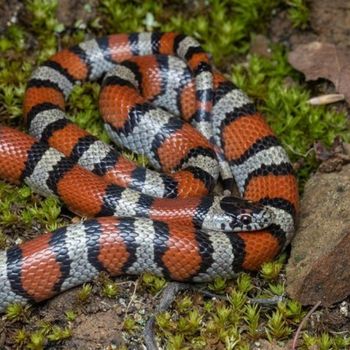 |
| 14 | North American Blue Racer (Coluber constrictor foxii) |
| 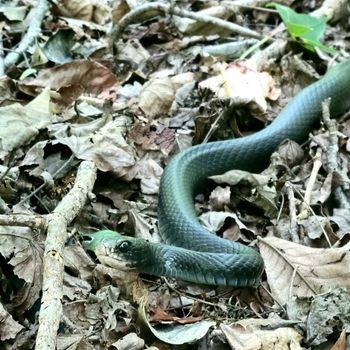 |
| 15 | Northern Ringneck Snake (Diadophis punctatus edwardsii) |
| 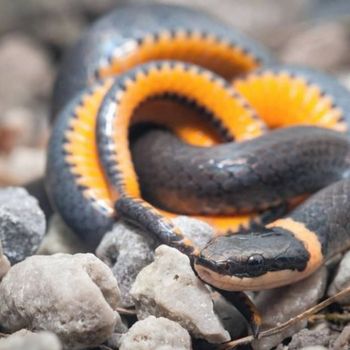 |
| 16 | Plains Garter Snake (Thamnophis radix) |
| 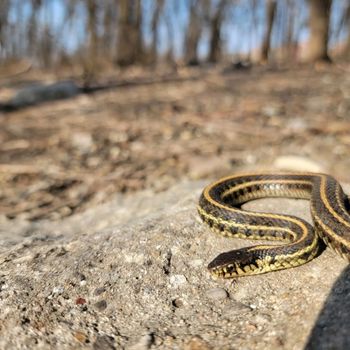 |
| 17 | Prairie Ringneck Snake (Diadophis punctatus arnyi) |
| 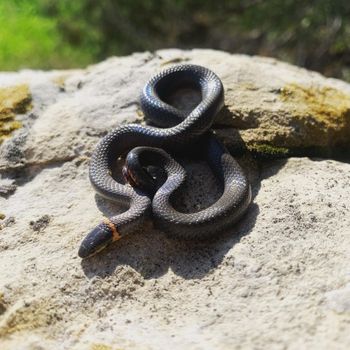 |
| 18 | Queen Snake (Regina septemvittata) |
| 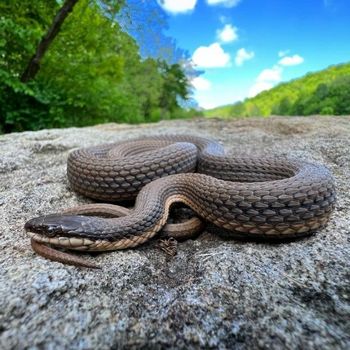 |
| 19 | Red-Bellied Snake (Storeria occipitomaculata) |
|  |
| 20 | Smooth Green Snake (Opheodrys vernalis) |
| 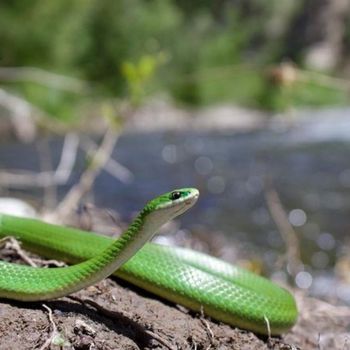 |
| 21 | Timber Rattlesnake (Crotalus horridus) |
|  |
| 22 | Western Ribbonsnake (Thamnophis proximus) |
| 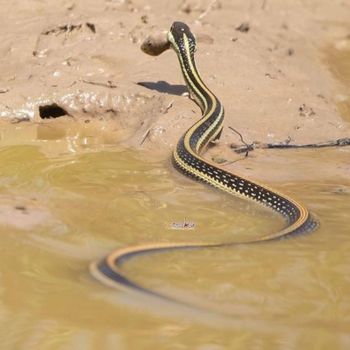 |
| 23 | Western Wormsnake (Carphophis vermis) |
| 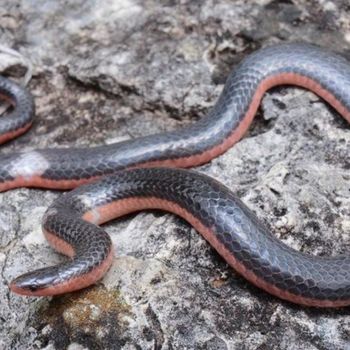 |
23 Snakes You Can Find in Wisconsin
In the state of Wisconsin, a fascinating array of serpents can be found slithering through its diverse landscapes. From venomous to harmless, each species has its unique story to tell. Below, we’ll explore the wonders of these often misunderstood creatures of Wisconsin, from their natural habitats and behaviors to the challenges they face in our changing world.
1. Black Rat Snake
- Scientific Name: Pantherophis obsoletus
- Common Name: Black rat snake
- Size: Up to 8 feet (2.4 meters)
- Natural Habitat: Forests, grasslands, and urban areas
- Color: Black with faint dark blotches
- Habitat: Forests, grasslands, and urban areas
- Maximum Size: Up to 8 feet (2.4 meters)
- Diet: Rodents, birds, and eggs
- Reproduction: Lay eggs in clutches of 5-30
- Venom: Non-venomous
- Conservation: Least concern
Pantherophis obsoletus, commonly known as Black Rat Snake, can grow up to 8 feet (2.4 meters) long, with a black and dark-blotched coloring. These non-venomous reptiles inhabit forests, grasslands, and urban areas of Wisconsin, showcasing diurnal and semi-arboreal behavior. Their diet consists of rodents, birds, and eggs. Female Black Rat Snakes lay eggs in clutches of 5-30 during the reproduction season. Although not endangered, these snakes play an important role in controlling rodent populations.
2. Bullsnake
- Scientific Name: Pituophis catenifer sayi
- Common Name: Bull snake
- Size: 4-6 feet (1.2-1.8 meters)
- Natural Habitat: Grasslands, deserts, woodlands, and agricultural areas
- Color: Brown or yellowish with dark blotches
- Habitat: Grasslands, deserts, woodlands, and agricultural areas
- Maximum Size: 4-6 feet (1.2-1.8 meters)
- Diet: Rodents, rabbits, ground-nesting birds, and eggs
- Reproduction: Lay eggs in clutches of 5-22
- Venom: Non-venomous
- Conservation: Least concern
The Bullsnake (Pituophis catenifer sayi), a non-venomous constrictor, measures 4-6 feet (1.2-1.8 meters) and exhibits a brown or yellowish color with dark blotches. Found in grasslands, deserts, woodlands, and agricultural areas, these diurnal and terrestrial snakes primarily feed on rodents, rabbits, ground-nesting birds, and eggs. During the reproduction, the female Bullsnake lays egg clutches ranging from 5-22. With a conservation status listed as “Least Concern”, the Bullsnake is not currently under threat in Wisconsin.
3. Butler’s Gartersnake
- Scientific Name: Thamnophis butleri
- Common Name: Butler’s gartersnake
- Size: Up to 27 inches (68.5 cm)
- Natural Habitat: Grasslands, marshes, and meadows
- Color: Black or brown with yellow or orange stripes
- Habitat: Grasslands, marshes, and meadows
- Maximum Size: Up to 27 inches (68.5 cm)
- Diet: Earthworms, slugs, and small amphibians
- Reproduction: Lay eggs in clutches of 4-12
- Venom: Non-venomous
- Conservation: Least concern
The Butler’s Gartersnake (Thamnophis butleri) is a non-venomous reptile that can grow up to 27 inches in length. Known for its black or brown coloration contrasted by yellow or orange stripes, this diurnal and terrestrial snake primarily inhabits grasslands, marshes, and meadows. Butler’s Gartersnake mainly feasts on earthworms, slugs, and small amphibians. Breeding season typically sees them laying egg clutches of 4-12. Currently, their conservation status is categorized as least concern.
4. Common Garter Snake
- Scientific Name: Thamnophis sirtalis
- Common Name: Common garter snake
- Size: Up to 3-4 feet (0.9-1.2 meters)
- Natural Habitat: Wet and moist habitats, including marshes, fields, and forests
- Color: Green or brown with three yellow stripes
- Habitat: Wet and moist habitats, including marshes, fields, and forests
- Maximum Size: Up to 3-4 feet (0.9-1.2 meters)
- Diet: Frogs, fish, earthworms, and small mammals
- Reproduction: Gives birth to live young, 10-40 per litter
- Venom: Mildly venomous, harmless to humans
- Conservation: Least concern
The Common Garter Snake (Thamnophis sirtalis) is a 3-4 feet (0.9-1.2 meters) non-aggressive and mildly venomous reptile with a green or brown body and three yellow stripes. Inhabiting wet and moist habitats like marshes, fields, and forests of Wisconsin, these diurnal snakes hibernate during winter to escape the cold. Their diet consists of frogs, fish, earthworms, and small mammals. Uniquely, these snakes birth live young, producing 10-40 per litter. Although venomous, they pose no threat to humans and are currently listed as a species of least concern for conservation.
5. Common Water Snake
- Scientific Name: Nerodia sipedon
- Common Name: Common water snake
- Size: Up to 4.5 feet (1.4 meters)
- Natural Habitat: Aquatic habitats, including lakes, rivers, and ponds
- Color: Brown or gray with dark bands or blotches
- Habitat: Aquatic habitats, including lakes, rivers, and ponds
- Maximum Size: Up to 4.5 feet (1.4 meters)
- Diet: Fish, frogs, and salamanders
- Reproduction: Give birth to live young in litters of 10-40
- Venom: Non-venomous, but can release a foul-smelling musk
- Conservation: Least concern
The Common Water Snake (Nerodia sipedon) is a non-venomous, nocturnal, semiaquatic reptile that can grow up to 4.5 feet (1.4 meters) in size. Their brown or gray body has dark bands or blotches as markings. Commonly found in aquatic habitats like lakes, rivers, and ponds, this snake’s diet consists of fish, frogs, and salamanders. It reproduces by giving birth to live young in litters containing 10-40 offspring. Although non-venomous, it can release foul-smelling musk in defense. Its conservation status is of least concern.
6. Dekay’s Brownsnake
- Scientific Name: Storeria dekayi
- Common Name: Dekay’s brown snake
- Size: 9-15 inches (23-38 cm)
- Natural Habitat: Forests, grasslands, wetlands, and urban areas
- Color: Brown or gray with dark spots
- Habitat: Forests, grasslands, wetlands, and urban areas
- Maximum Size: 9-15 inches (23-38 cm)
- Diet: Earthworms, slugs, and other soft-bodied invertebrates
- Reproduction: Give birth to live young (ovoviviparous), 3-40 offspring
- Venom: Non-venomous
- Conservation: Least concern
Storeria dekayi, commonly known as Dekay’s Brown Snake, is a small, non-venomous reptile, measuring 9-15 inches (23-38 cm) in length. Its brown or gray body features dark spots, and it inhabits forests, grasslands, wetlands, and urban areas. Exhibiting terrestrial, nocturnal, and secretive behavior, its diet consists primarily of earthworms, slugs, and other soft-bodied invertebrates. A fascinating ovoviviparous species, Dekayís Brown Snake gives birth to live young, bearing 3-40 offspring. Its current conservation status is classified as least concern.
7. Eastern Fox Snake
- Scientific Name: Pantherophis gloydi
- Common Name: Eastern fox snake
- Size: Up to 5 feet (1.5 meters)
- Natural Habitat: Wetlands, meadows, and woodland edges
- Color: Yellowish or light brown with dark blotches
- Habitat: Wetlands, meadows, and woodland edges
- Maximum Size: Up to 5 feet (1.5 meters)
- Diet: Rodents, birds, and eggs
- Reproduction: Lay eggs in clutches of 8-27
- Venom: Non-venomous
- Conservation: Least concern
The Eastern Fox Snake (Pantherophis gloydi) is a non-venomous reptile, reaching up to 5 feet (1.5 meters) in length. It has a yellowish or light brown color, adorned with dark blotches. Commonly found in wetlands, meadows, and woodland edges, this nocturnal and terrestrial creature feeds primarily on rodents, birds, and eggs. During the reproduction process, Eastern Fox Snakes lay eggs in clutches of 8-27. Though marked as “least concern” in conservation status, their survival is vital to maintaining ecological balance.
8. Eastern Hog-nosed Snake
- Scientific Name: Heterodon platirhinos
- Common Name: Eastern hog-nosed snake
- Size: 20-33 inches (51-84 cm)
- Natural Habitat: Woodlands, grasslands, and sandy areas
- Color: Highly variable, typically brown or gray with dark blotches
- Habitat: Woodlands, grasslands, and sandy areas
- Maximum Size: 20-33 inches (51-84 cm)
- Diet: Mostly toads, but also other amphibians and small mammals
- Reproduction: Lay eggs, 4-60 per clutch
- Venom: Mild venom, harmless to humans
- Conservation: Least concern
The Eastern Hog-nosed Snake (Heterodon platirhinos) is a moderately-sized serpent, reaching lengths of 20-33 inches (51-84 cm). Its coloration is highly variable, typically exhibiting brown or gray hues with dark blotches. Inhabiting woodlands, grasslands, and sandy areas, this diurnal snake is known for playing dead when threatened. Its diet mainly consists of toads, along with other amphibians and small mammals. It reproduces by laying 4-60 eggs per clutch, has mild venom harmless to humans, and is classified as of “Least Concern” in conservation efforts.
9. Eastern Ribbon Snake
- Scientific Name: Thamnophis sauritus sauritus
- Common Name: Eastern ribbon snake
- Size: 18-34 inches (45-86 cm)
- Natural Habitat: Wetlands, swamps, and marshes near water
- Color: Black, greenish, or brown with three distinct light stripes
- Habitat: Wetlands, swamps, and marshes near water
- Maximum Size: 18-34 inches (45-86 cm)
- Diet: Frogs, toads, small fish, and insects
- Reproduction: Lay 3-27 eggs, sometimes communal with other snakes
- Venom: Non-venomous
- Conservation: Least concern
The Eastern Ribbon Snake, scientifically known as Thamnophis sauritus sauritus, is a non-venomous reptile measuring 18-34 inches (45-86 cm). It inhabits wetlands, swamps, and marshes near water and features a distinctive black, greenish, or brown color with three light stripes. Known for their daytime activity and skittish behavior, these snakes are excellent swimmers with a diet comprising frogs, toads, small fish, and insects. They reproduce by laying 3-27 eggs, sometimes communally with other snakes. Their conservation status is of least concern.
10. Gophersnake
- Scientific Name: Pituophis catenifer
- Common Name: Gophersnake
- Size: Up to 7 feet (2.1 meters)
- Natural Habitat: Deserts, grasslands, forests, and agricultural areas
- Color: Yellow, brown, or cream with dark spots
- Habitat: Deserts, grasslands, forests, and agricultural areas
- Maximum Size: Up to 7 feet (2.1 meters)
- Diet: Mammals, birds, eggs, and reptiles
- Reproduction: Lay eggs in clutches of 2-24
- Venom: Non-venomous
- Conservation: Least concern
The Gophersnake (Pituophis catenifer) is a non-venomous snake species measuring up to 7 feet (2.1 meters) in length. They exhibit yellow, brown, or cream-colored scales with dark spots. Gophersnakes thrive in various habitats such as deserts, grasslands, forests, and agricultural areas. These diurnal, burrow-dwelling reptiles primarily feed on mammals, birds, eggs, and other reptiles. Gophersnakes reproduce through laying egg clutches, consisting of 2-24 eggs. Currently, they have a conservation status of least concern.
11. Lined Snake
- Scientific Name: Tropidoclonion lineatum
- Common Name: Lined snake
- Size: Up to 20 inches (51 cm)
- Natural Habitat: Grasslands, prairies, and urban areas
- Color: Gray or tan with dark stripes
- Habitat: Grasslands, prairies, and urban areas
- Maximum Size: Up to 20 inches (51 cm)
- Diet: Earthworms, slugs, and soft-bodied insects
- Reproduction: Lay eggs in clutches of 2-12
- Venom: Non-venomous
- Conservation: Least concern
The Lined Snake (Tropidoclonion lineatum) is a small, non-venomous species, growing up to 20 inches (51 cm). It has a gray or tan colored body with dark stripes, adapted to living in grasslands, prairies, and urban areas. Being nocturnal and fossorial, this reptile primarily feeds on earthworms, slugs, and soft-bodied insects. Lined Snakes reproduce by laying eggs in clutches of 2-12. With a conservation status of least concern, they remain a thriving species.
12. Massasauga Rattlesnake
- Scientific Name: Sistrurus catenatus
- Common Name: Massasauga rattlesnake
- Size: 18-30 inches (46-76 cm)
- Natural Habitat: Grasslands, marshes, and woodland areas
- Color: Gray or light brown with dark banding
- Habitat: Grasslands, marshes, and woodland areas
- Maximum Size: 18-30 inches (46-76 cm)
- Diet: Small mammals, lizards, and amphibians
- Reproduction: Give birth to live young in litters of 5-20
- Venom: Venomous (hemotoxic)
- Conservation: Least concern
The Massasauga Rattlesnake (Sistrurus catenatus) is a small venomous snake, growing up to 18-30 inches (46-76 cm) in length. Exhibiting gray or light brown coloring with dark banding, it thrives in habitats such as grasslands, marshes, and woodland areas. This nocturnal, secretive, and terrestrial snake predominantly feeds on small mammals, lizards, and amphibians. Its reproduction involves giving birth to live young in litters ranging from 5-20. With hemotoxic venom, the snake currently has a conservation status of “Least Concern.”
13. Milksnake
- Scientific Name: Lampropeltis triangulum
- Common Name: Milksnake
- Size: 20 to 60 inches (50 to 150 cm)
- Natural Habitat: Various habitats, including forests, grasslands, and rocky hillsides
- Color: Red or orange with black and white bands
- Habitat: Various habitats, including forests, grasslands, and rocky hillsides
- Maximum Size: 20 to 60 inches (50 to 150 cm)
- Diet: Rodents, birds, eggs, and other reptiles
- Reproduction: Lay eggs in clutches of 2-17
- Venom: Non-venomous
- Conservation: Least concern
The Milksnake (Lampropeltis triangulum) is a non-venomous and nocturnal reptile, ranging in size from 20 to 60 inches (50 to 150 cm) in length. It exhibits vibrant colors like red or orange, with black and white bands. Milksnakes inhabit various environments, such as forests, grasslands, and rocky hillsides. Their secretive nature makes them difficult to spot. The species primarily feeds on rodents, birds, eggs, and other reptiles. Reproduction involves laying egg clutches of 2-17. Currently, their conservation status is of least concern.
14. North American Blue Racer
- Scientific Name: Coluber constrictor foxii
- Common Name: North american blue racer
- Size: Up to 6 feet (1.8 meters)
- Natural Habitat: Grasslands, meadows, woodland edges, and urban areas
- Color: Blue or blue-green with white or pale gray belly
- Habitat: Grasslands, meadows, woodland edges, and urban areas
- Maximum Size: Up to 6 feet (1.8 meters)
- Diet: Small mammals, birds, reptiles, insects, and frogs
- Reproduction: Lay eggs in clutches of 5-20
- Venom: Non-venomous
- Conservation: Least concern
The North American Blue Racer (Coluber constrictor foxii) is a swift, non-aggressive snake with striking blue or blue-green scales and a white or pale gray belly. Reaching lengths of up to 6 feet (1.8 meters), this non-venomous serpent thrives in grasslands, meadows, woodland edges, and urban areas. Active during the day, it preys on small mammals, birds, reptiles, insects, and frogs. The Blue Racer lays eggs in clutches of 5-20 and is currently labeled as “Least Concern” in conservation status.
15. Northern Ringneck Snake
- Scientific Name: Diadophis punctatus edwardsii
- Common Name: Northern ringneck snake
- Size: 12-15 inches, rarely up to 24 inches
- Natural Habitat: Woodlands, rock outcrops, and grasslands
- Color: Gray or black with a distinctive yellow or orange ring around the neck
- Habitat: Woodlands, rock outcrops, and grasslands
- Maximum Size: 12-15 inches, rarely up to 24 inches
- Diet: Small invertebrates, slugs, earthworms, and small amphibians
- Reproduction: Lay eggs in clutches of 3-10
- Venom: Mildly venomous, but harmless to humans
- Conservation: Least concern
The Northern Ringneck Snake (Diadophis punctatus edwardsii) is a small, mildly venomous snake native to North America, measuring 12-15 inches in length, rarely reaching up to 24 inches. Its body color varies from gray to black and features a distinctive yellow or orange ring around its neck. The species inhabits woodlands, rock outcrops, and grasslands, exhibiting nocturnal, secretive, and terrestrial behavior. Its diet consists of small invertebrates, slugs, earthworms, and small amphibians. These snakes reproduce by laying egg clutches of 3-10 and pose no threat to humans. Their conservation status is listed as least concern.
16. Plains Garter Snake
- Scientific Name: Thamnophis radix
- Common Name: Plains garter snake
- Size: 16-28 inches (41-71 cm)
- Natural Habitat: Grasslands, wetlands, and areas near water sources
- Color: Brown or gray with yellow or orange stripes
- Habitat: Grasslands, wetlands, and areas near water sources
- Maximum Size: 16-28 inches (41-71 cm)
- Diet: Earthworms, amphibians, fish, and invertebrates
- Reproduction: Live-bearing; 6-80 offspring per litter
- Venom: Non-venomous
- Conservation: Least concern
The Plains Garter Snake (Thamnophis radix) is a non-venomous reptile characterized by its brown or gray color with yellow or orange stripes. Typically measuring 16-28 inches (41-71 cm) in length, it thrives in grasslands, wetlands, and areas near water sources. These diurnal, semi-aquatic snakes are known for their swimming prowess. They feed primarily on earthworms, amphibians, fish, and invertebrates. Mating results in live births, producing 6-80 offspring per litter. Currently, their conservation status is of least concern.
17. Prairie Ringneck Snake
- Scientific Name: Diadophis punctatus arnyi
- Common Name: Prairie ringneck snake
- Size: 10-15 inches (25-38 cm)
- Natural Habitat: Prairies, grasslands, and woodlands
- Color: Gray or olive with a yellow or orange ring around the neck
- Habitat: Prairies, grasslands, and woodlands
- Maximum Size: 10-15 inches (25-38 cm)
- Diet: Earthworms, slugs, small salamanders, and insects
- Reproduction: Lay eggs in clutches of 3-10
- Venom: Weak venom, not dangerous to humans
- Conservation: Least concern
The Prairie Ringneck Snake (Diadophis punctatus arnyi) is a small reptile measuring 10-15 inches (25-38 cm) in length, characterized by its gray or olive coloring and distinctive yellow or orange ring around its neck. These snakes are native to prairies, grasslands, and woodlands, leading a predominantly nocturnal, secretive, and burrow-dwelling lifestyle. Their diet consists of earthworms, slugs, small salamanders, and insects. They lay eggs in clutches of 3-10 and possess weak venom which poses no threat to humans. Currently, their conservation status is listed as “least concern.”
18. Queen Snake
- Scientific Name: Regina septemvittata
- Common Name: Queen snake
- Size: Up to 3 feet (0.9 meters)
- Natural Habitat: Streams, creeks, and other aquatic environments
- Color: Olive, brown or gray with three stripes and cream or yellowish belly
- Habitat: Streams, creeks, and other aquatic environments
- Maximum Size: Up to 3 feet (0.9 meters)
- Diet: Crayfish and other small aquatic invertebrates
- Reproduction: Lay eggs in clutches of 4-14
- Venom: Non-venomous
- Conservation: Least concern
The Queen Snake (Regina septemvittata) is a non-venomous reptile growing up to 3 feet (0.9 meters) in length. Often sporting olive, brown, or gray coloration, this snake displays three distinctive stripes and a yellowish belly. It thrives in aquatic habitats such as streams and creeks, and is highly active during the day. Queen Snakes primarily feed on crayfish and other small aquatic invertebrates. They lay eggs in clutches of 4-14, and currently face no significant conservation threats.
19. Red-Bellied Snake
- Scientific Name: Storeria occipitomaculata
- Common Name: Red-bellied snake
- Size: 8-16 inches (20-41 cm)
- Natural Habitat: Forests, woodlands, and wetlands
- Color: Gray or brown with a red or orange belly
- Habitat: Forests, woodlands, and wetlands
- Maximum Size: 8-16 inches (20-41 cm)
- Diet: Slugs, snails, and earthworms
- Reproduction: Live-bearing; 4-21 offspring per litter
- Venom: Non-venomous
- Conservation: Least concern
The Red-Bellied Snake (Storeria occipitomaculata) is a small, non-venomous snake measuring 8-16 inches (20-41 cm) in length. They are gray or brown with a distinctive red or orange belly. Mostly found in forests, woodlands, and wetlands of Wisconsin, these nocturnal and secretive creatures primarily feed on slugs, snails, and earthworms. As live-bearing reptiles, they produce 4-21 offspring in each litter. With a conservation status of “Least Concern,” this terrestrial snake presents no significant threat to humans.
20. Smooth Green Snake
- Scientific Name: Opheodrys vernalis
- Common Name: Smooth green snake
- Size: 14-20 inches (36-51 cm)
- Natural Habitat: Grasslands, meadows, and open woodlands
- Color: Bright green with a lighter belly
- Habitat: Grasslands, meadows, and open woodlands
- Maximum Size: 14-20 inches (36-51 cm)
- Diet: Insects and spiders
- Reproduction: Lay eggs in clutches of 3-12
- Venom: Non-venomous
- Conservation: Least concern
The Smooth Green Snake (Opheodrys vernalis) measures 14-20 inches (36-51 cm) and is characterized by its vibrant green color and lighter belly. Commonly found in grasslands, meadows, and open woodlands, this diurnal and terrestrial reptile is an adept climber. Its diet mainly consists of insects and spiders. In terms of reproduction, they lay eggs in clutches of 3-12. Though non-venomous, these snakes should be admired from afar. Fortunately, their conservation status is currently listed as ‘Least Concern.’
21. Timber Rattlesnake
- Scientific Name: Crotalus horridus
- Common Name: Timber rattlesnake
- Size: Up to 6 feet (1.8 meters)
- Natural Habitat: Forests, mixed woodlands, and rocky hillsides
- Color: Yellow, brown, gray, or black with dark bands
- Habitat: Forests, mixed woodlands, and rocky hillsides
- Maximum Size: Up to 6 feet (1.8 meters)
- Diet: Rodents, birds, and small mammals
- Reproduction: Viviparous, giving birth to 4-14 live young
- Venom: Hemotoxic venom
- Conservation: Least concern
The Timber Rattlesnake, scientifically known as Crotalus horridus, is a solitary, ambush predator that can grow up to 6 feet (1.8 meters) in length. It comes in various colors, including yellow, brown, gray, or black with dark bands, and inhabits forests, mixed woodlands, and rocky hillsides. Its diet consists of rodents, birds, and small mammals. Unlike most snakes, the Timber Rattlesnake is viviparous, giving birth to 4-14 live young. It possesses hemotoxic venom, and its conservation status is currently listed as least concern.
22. Western Ribbonsnake
- Scientific Name: Thamnophis proximus
- Common Name: Western ribbonsnake
- Size: 18-30 inches (46-76 cm)
- Natural Habitat: Semi-aquatic habitats, wetlands, marshes, and grasslands near water
- Color: Black or dark brown with three bright yellow or white stripes
- Habitat: Semi-aquatic habitats, wetlands, marshes, and grasslands near water
- Maximum Size: 18-30 inches (46-76 cm)
- Diet: Fish, frogs, and tadpoles
- Reproduction: Lay eggs in clutches of 3-26
- Venom: Non-venomous
- Conservation: Least concern
The Western Ribbonsnake (Thamnophis proximus) is a slender reptile measuring 18-30 inches (46-76 cm) in length, characterized by its black or dark brown coloration adorned with three bright yellow or white stripes. Commonly found in semi-aquatic habitats such as wetlands, marshes, and grasslands near water, this diurnal creature is a swift swimmer, preying primarily on fish, frogs, and tadpoles. The non-venomous species reproduces by laying egg clutches of 3-26, and has a conservation status of ‘Least Concern’.
23. Western Wormsnake
- Scientific Name: Carphophis vermis
- Common Name: Western wormsnake
- Size: Up to 14 inches (35.5 cm)
- Natural Habitat: Deciduous forests, grasslands, and suburban areas with moist soil
- Color: Brown to black on the back and pink or light brown on the belly
- Habitat: Deciduous forests, grasslands, and suburban areas with moist soil
- Maximum Size: Up to 14 inches (35.5 cm)
- Diet: Earthworms and other soft-bodied invertebrates
- Reproduction: Lay eggs in clutches of 1-8
- Venom: Non-venomous
- Conservation: Least concern
The Western Wormsnake (Carphophis vermis) is a non-venomous, small-sized reptile reaching up to 14 inches (35.5 cm) in length. It exhibits a distinct color pattern of brown-to-black on its back and pink or light brown on its belly. Inhabiting deciduous forests, grasslands, and moist suburban areas, this elusive, nocturnal creature primarily burrows underground and feeds on earthworms and soft-bodied invertebrates. Western Wormsnakes lay small egg clutches (1-8) and have a conservation status of Least Concern.
Nearby States:
Are Badger Slitherers and Garden State Slitherers the Same Species of Snake?
Yes, Badger Slitherers and Garden State Slitherers are indeed the same species of snakes in new jersey. Despite being known by different names in different regions, they are both non-venomous and commonly found in gardens and wooded areas throughout the state.
Final Words
All the 23 snakes have truly opened our eyes to the fascinating world of snakes found in Wisconsin. Who knew there were so many different types of these slithering reptiles, each with their own unique characteristics and habitats?
Not only did we get a chance to learn about some of the more common and well-known species, but we also delved into the lesser-known and often misunderstood ones.
So, the next time you’re out and about in Wisconsin, keep an eye out for these incredible creatures, and let’s continue to appreciate and protect the diverse wildlife that makes our world so interesting!



